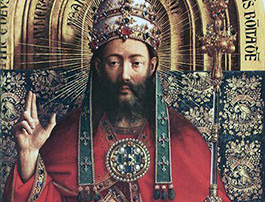Jesus Christ Is Our True King and Priest
- JANET E. SMITH
"Christ as our Redeemer purchased the Church at the price of his own blood; as priest he offered himself, and continues to offer himself as a victim for our sins.
 Is it not evident, then, that his kingly dignity partakes in a manner of both these offices?" - Pope Pius XI
Is it not evident, then, that his kingly dignity partakes in a manner of both these offices?" - Pope Pius XI
We who live in a democracy and are shaped by its values face significant obstacles in embracing the Catholic worldview. We strongly believe in the equality of all persons — a view that has its legitimacy, of course, but which also hinders us from appreciating the fundamental hierarchical nature of the universe, a structure better represented by monarchy than by democracy.
To our mind, kings are a folly of the past, a time when people did not recognize the right of people to be self-ruled. We seem to be aware primarily of kings who were tyrannical or mentally ill, not those who were just and benevolent and patrons of all good things — and indeed, even saintly.
The notion of royalty is at best amusing to us — royalty are celebrities with a title — and more often is offensive. We find it fundamentally unjust that someone should rule over a nation simply because he or she was born into a royal family who have wealth and power bestowed upon them by birthright and who do not necessarily possess any talent for governing.
Even more, we find it intolerable to think of ourselves as subjects or servants of anyone. Is that why we barely notice that we address God and his Son as Lord throughout the liturgy and we pray that his kingdom comes? Or is it that we don't have in our imaginations anymore what a kingdom looks like; what a king does for and deserves from his people?
But the fact is that Christ is King and Ruler of the Universe; we are his subjects and servants and phenomenally blessed to be so. Scripture presents God's people who, when faithful, loved to go to the king's house, and went there expecting justice, beautiful surroundings, music and dress, as well as fine food and drink.
Those who died faithful expected to gain a crown and even a kingdom — the idea is that someday we would all be kings, not senators or presidents. When I tell my friends I want a crown, they all laugh, but I mean it. I believe the saints in heaven all have a domain over which they "rule" by pouring graces on those who ask for them and need them — perhaps one of the reasons for the notion of saints who are patrons over certain causes.
Our failure to appreciate fully that Christ is King makes it difficult to understand properly elements of his life — such as, oddly enough, his Nativity. Most of us love a story of someone born in humble circumstances who rises to power, and thus we are not fully aware of what the Nativity really is. It is about a King who became a humble vagabond and died a dreadful death — not a story of a rise to power from lowly origins. Christ is a King who voluntarily took on poverty and humility and who spent his life trying to escape from the evil powers of an invisible evil kingdom. He then suffered an apparent definitive defeat by them.
Is it that we don't have in our imaginations anymore what a kingdom looks like; what a king does for and deserves from his people?
I find one the great appeals of the traditional Latin Mass is that it fittingly expresses and represents Christ as King. Going to the TLM feels like going to the palace of the king, where pageantry and grandeur are all together fitting — something we do not see much of in a democracy, and when we do, we find it a bit strange, if also strangely appealing. Indeed, one designation for a Church of a certain dignity is a "basilica," or the king's house — and it is in those settings that the TLM can be offered in its full glory.
At the TLM, it is clear that the priest, the altar boys and the congregation are meant to be humble before the King. The altar is approached reverently with songs of praise and statements of humility, of repeated expressions of contrition and gratitude. The congregation is not the focus. The offering/sacrifice that we make to the King is one we were told we must make and we did not design it; we are being obedient to our benevolent King/God. What focus there is on the congregation is on a people who are grateful to a God who "formed" us and who then "reformed" us after we had sinned. We ask for salvation for ourselves, for our families, for our deceased loved ones, for everyone in our company and "for the whole world." Our King is one who can do this for all of us.
Is not a great part of the appeal of the TLM the precision and piety of the altar boys and the "oddness" of their apparel? They are engaged in an activity that is not of this world. Yes, we know the angelic demeanor of the altar boys does not last much past the church doors, but oh, to watch them attempt to perform everything in accord with the rubrics is delightful and edifying.
Over the years, we watch the little ones, often so small they are in danger of tripping over their cassocks, rise in the ranks. We marvel at their ability to kneel ramrod straight through the distribution of Communion with only the occasional fidget and yawn. We note that the older boys have one assignment one week and another the next until they graduate to master of ceremonies. The little boys love to be in the company of the older ones and the older ones love to guide and instruct the young ones. This is not a democracy, but a hierarchy, where they serve at the altar of the King.
The garb of the priest and deacons is also otherworldly, grand and even regal — fitting a divine event. Still, the priest is not the King himself — he serves at the throne or altar of the King and offers a suitable sacrifice of thanksgiving to him. The all-powerful and all-loving God has made the ultimate sacrifice for us — he has given us his Son. The only suitable sacrifice is to give back to God what he has given us — again, his Son, in the form of transubstantiated bread and wine. Moreover, since he has created us and given us to ourselves, the only suitable return gift is the gift of ourselves, free from sin and perfected — which we can become only by uniting with his Son.
The TLM conveys not only the sense of royalty but of a divine royalty.
The TLM conveys not only the sense of royalty but of a divine royalty. The candles and the incense, the washing of hands and the precise movements, all convey that we are involved in a supernatural activity that removes us from this time and place to another, where our usual behavior is just too casual. The fact that we reverently and submissively kneel to receive the Blessed Sacrament and will not touch the sacred host drives home that this feast is no earthly celebration.
Churches built for the celebration of the TLM differ radically from the churches built for the Novus Ordo. The music written for the TLM is transcendent; that for the Novus Ordo is "popular." The apparel worn by the congregation at the TLM is mostly dignified; that at the Novus Ordois mostly casual. Nonetheless, the love the "strangeness" of all that goes on for the very atmosphere elevates their spirits and helps them know they are in a world not of their own making. Those who attend the Novus Ordo are quite comfortable since it is a Mass for the people, not for the King — a Mass with many moving parts to meet the ever-shifting "needs" of the people.
One of the appeals of the TLM at this time may be that our democracy, established by virtuous people, directed toward forming virtuous people, and requiring virtuous officials for it to be just, is quickly degenerating into a tyranny (as Plato predicted would happen with democracies unfettered from virtue) that has no respect either for God or human dignity.
The TLM, on the other hand, "reeks" of the dignity (and fragility) of human nature, the grandeur of God and his benevolence to his people. The TLM represents and conveys the hierarchical, ordered, stable reality that is the Kingdom of God. We need it now more than ever.
 This is Meaghen Gonzalez, Editor of CERC. I hope you appreciated this piece. We curate these articles especially for believers like you.
This is Meaghen Gonzalez, Editor of CERC. I hope you appreciated this piece. We curate these articles especially for believers like you.
Please show your appreciation by making a $3 donation. CERC is entirely reader supported.

Acknowledgement
 Janet E. Smith. "Jesus Christ Is Our True King and Priest." National Catholic Register (March 31, 2022).
Janet E. Smith. "Jesus Christ Is Our True King and Priest." National Catholic Register (March 31, 2022).
© 2022 EWTN News, Inc. Reprinted with permission from the National Catholic Register. Image credit: Jan van Eyck, Public domain, via Wikimedia Commons.
The Author

 Janet E. Smith holds the Father Michael J. McGivney Chair of Life Ethics at Sacred Heart Major Seminary in Detroit. She is the author of Living the Truth in Love: Pastoral Approaches to Same-Sex Attraction, In the Beginning . . .: A Theology of the Body, Life Issues, Medical Choices: Questions and Answers for Catholics, The Right to Privacy (Bioethics & Culture), Humanae Vitae: A Generation Later and the editor of Why Humanae Vitae Was Right. Prof. Smith has received the Haggar Teaching Award from the University of Dallas, the Prolife Person of the Year from the Diocese of Dallas, and the Cardinal Wright Award from the Fellowship of Catholic Scholars. She was named Catholic of the Year by Our Sunday Visitor in 2015. Over a million copies of her talk, "Contraception: Why Not" have been distributed. Visit Janet Smith's web page here. See Janet Smith's audio tapes and writing here. Janet Smith is on the Advisory Board of the Catholic Education Resource Center.
Janet E. Smith holds the Father Michael J. McGivney Chair of Life Ethics at Sacred Heart Major Seminary in Detroit. She is the author of Living the Truth in Love: Pastoral Approaches to Same-Sex Attraction, In the Beginning . . .: A Theology of the Body, Life Issues, Medical Choices: Questions and Answers for Catholics, The Right to Privacy (Bioethics & Culture), Humanae Vitae: A Generation Later and the editor of Why Humanae Vitae Was Right. Prof. Smith has received the Haggar Teaching Award from the University of Dallas, the Prolife Person of the Year from the Diocese of Dallas, and the Cardinal Wright Award from the Fellowship of Catholic Scholars. She was named Catholic of the Year by Our Sunday Visitor in 2015. Over a million copies of her talk, "Contraception: Why Not" have been distributed. Visit Janet Smith's web page here. See Janet Smith's audio tapes and writing here. Janet Smith is on the Advisory Board of the Catholic Education Resource Center.




